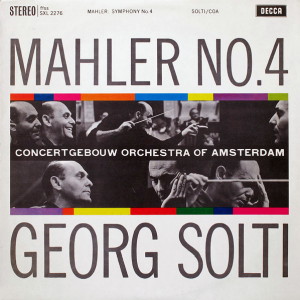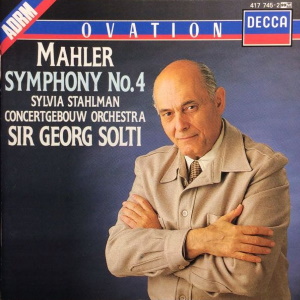 |
|
1 LP -
SXL 2276 - (p) 1961
|
 |
| 1 CD -
417 745-2 - (p) 1988 |
|
| GUSTAV
MAHLER (1860-1911) |
|
|
|
|
|
|
|
| Symphony No. 4 in
G Major |
|
54' 19" |
|
| - 1. Heiter,
Bedachtig, Nicht Eilen |
15' 47" |
|
|
| - 2. In Gemšchlicher
Bewegung |
8' 45" |
|
|
| -
3. Ruhevoll |
21' 02" |
|
|
| -
4. Sehr Behaglich |
8' 45" |
|
|
|
|
|
|
Sylvia Stahlman,
soprano (4)
|
|
| Concertgebouw
Orchestra of Amsterdam |
|
| - Steven Staryk, solo
violin (2) |
|
| Georg Solti,
conductor |
|
|
|
|
|
Luogo
e data di registrazione |
|
Concertgebouw,
Amsterdam (Olanda) - febbraio 1961 |
|
|
Registrazione:
live / studio |
|
studio |
|
|
Producer |
|
John
Culshaw
|
|
|
Recording
engineers |
|
Kenneth
Wilkinson |
|
|
Prima Edizione
LP |
|
Decca
ffss | SXL 2276 (stereo) - LXT
5638 (mono) | (1 LP) | durata 54'
19" | (p) 1961 | Analogico
|
|
|
Edizione CD |
|
Decca
"Ovation" | 417 745-2 | (1 CD) |
durata 54' 19" | (c) 1988 | ADD
(ADRM) |
|
|
Note |
|
The
Decca Record Company Limited,
London, England
|
|
|
|
|
|
Despite some
early appreciation and
encouragement by Richard
Strauss, most of Mahler's
compositions were
misunderstood in his
lifetime and passed
unappreciated by critics and
public alike. The general
opinion of his music coupled
with his dictatorial and
uncompromising
administration of his
various operatic
appointments created a wave
of hostility against the
composer that was only
partly offset by his
brilliant reputation as a
conductor. Thus it is only
recently that Mahler, a
legendary figure for his
unequalled artistic
direction of the Vienna
Opera, has started to
receive full recognition as
a composer.
One of the
last to appear on the sce of
the Romantic Movement,
Mahler appears to have been
subject to the influence of
the highly developed
romanticism that manifested
iteself particularly in
Wagner's later works and
Liszt's symphonic poems. He
was also caught up in the
wave of interest in
folk-music in addition to
the many collections of
these by minor composers
Brahms' efforts in this
direction such as the German
Folk-songs and Hungarian
Dances are well-known -
which was then inspiring
composers to create an art
that embraced the simple
directness of the German
folk-song without departing
from the idiom of expression
and orchestral apparatus of
the period. Mahler's Fourth
Symphony is a child of these
ideas, as will be seen
below.
For the composer life was a
grim struggle, a constant
battle against ill-health
and financial insecurity.
Torn between the rival
occupations of conductor and
composer, the unfortunate
man was ever compromising
between the two, for the one
was lucrative whereas the
other definitely was not.
The unhappy result was that
Mahler became, like Borodin
and so many others, a
'Sunday Composer', writing
only when either ill or on
holiday, the rest of the
time striving to fulfil
engagements as a conductor
which his delicate
constitution could not and
did not endure. He was
bornat Kalsicht on July 7th,
1860, the son of a
Moravian-Jewish merchant and
distiller, and his early
years were ones of extreme
poverty. Fortunately promise
as a pianist secured him a
sound musical education at
the hands of one Julius
Eostein in Vienna. His
student sketches were
regarded as "promising", and
it was not until he started
to practise a musical career
that antagonism towards his
works really began. Typical
of the unfavourable
atmosphere Mahler had to
endure was the incident of
1880 when he submitted the
earliest work of his to have
survived, Das klagende
Lied, for a
competition whose jury
included Brahms and
Hanslick. Unfortunately the
format did not like Mahler
(or his friends Rott und
Hugo Wolf) apparently for no
better reason than that they
were artistically
sympathetic to Bruckner, a
composer whose music Brahms
detested, and the inevitable
result was the rejection of
the piece. In the same year
Mahler began his conducting
career at the Cassel Opera,
an appointment which led to
silmilar positions at Prague
and Leipzig, but it was not
until he was engaged by the
Budapest Opera in 1888 that
he was able to demonstrate
his powers as administrator,
producer, organiser and
conductor. For the first
time he had a good orchestra
and singers at his command
and could give productions
that measured up to his own
artistic standards. It was
here that the first uncut
performances of Wagner's Ring
in Hungarian were given (in
a class said to be
comparable to that of
Bayreuth), and it was here
that his tylish production
of Don Giovanni won
him, at long last, the
friedenship of the ageing
Brahms.
It was here, too, that the
Fourth Symphony was created.
Completed early in 1900, the
work was first performed in
November of the following
year, with the composer
conducting. The simplest and
least overshadowed by gloomy
thoughts of all his
symphonies, it has now be
come one of his most
popular. As has already been
mentioned it is closely
connected with the movement
that favoured a new
simplicity of style -
although not always
expressing a simple subject
- attired in a heavy
romantic apparel (wich is
nonetheless never allowed,
in Mahler's hands, to
occlude the clarity of his
expression). This work has
as a central idea the
expression of a child's view
of heaven, a theme which is
expanded in the last
movement by a setting of
verses from an anthology of
German folk-poems called Des
Knaben Wunderhorn, a
work which had already
provided inspiration for
much of Mahler's music. The
vision is naÔve in the
extreme - the emphasis being
on the quantities of food
and drink which abound in
heaven - and yet is
presented in so apt and
charming a way that the
desired effect is
immediately created.
After a brief introduction
in which the four flutes and
jingle bells which Mahler
included in the score
feature prominently, the
first subject, a graceful
andlifting violin melody is
introduced. It creates the
comfortable and unhurried
atmosphere of good humour
which is to prove the
predominant mood of the
whole symphony. The second
group of themes are soon
introduced on the cellos: a
pleasantly jocular subject
is heard in duet, first
between oboe and bassoon,
then upper and lower strings
and so on. The bells usher
in a repeat of the first
subject, and an extended
development follows. The
flutes then introduce a new
theme, which is to be heard
later in all the three
subsequent movements, and
this is worked up to a
climax marked by
fanfare-like trumpet calls.
Bells and flutes return and
a recapitolation of the main
theme, at first disguised,
is achieved at lenght. An
expressive horn recitative
makes way for a brief and
jubilant coda which
concludes the movement.
The second movement is in
the form of a scherzo with a
rather L„ndler-like trio. An
introductory passage for
solo horn makes way for the
first violin to whom is
given the grotesque
principal theme of this
scherzo. Mahler instructs
that the instrument is to be
tuned a tone sharp and
played "like a fiddle"
(implying a street
musician's fiddle rather
than an orchestral one) on
order to divest it of all
charm of sound. This device
will bring to the minds of
many the similar idea
in Saint-SaŽns Danse
Macabre - a
resemblance which is
explained when one recalls
that Mahler referred to this
movement as Freund Hein
spielt auf ("Death
plays on").
The third movement begins
with a beautiful and restful
melody which is developed
with increasing intricacy
and vigour in a set of
variations, an ostinato
bass plucked on the
double-basses serving to
link them together. The
tempo primo is resumed in
the last variation, and
there is then a violent
outburst of the full
orchestra; at this point
Mahler transfers the
double-bass' part to the
timpani and, with wonderful
effect, the ostinato
is crashed out on the drums
with full force. The clamour
gradually dies away and
eventually ends pianissimo
with the unearthly sounds of
violin harmonics, supported
by the flutes.
In the final movement the
soprano solo sings the
child's announcement that
she really is in heaven,
enjoying its gastronimic
delights. There is a simple
but colourful introduction,
after which the first stanza
of the poem, which tells of
the merry children's games
that go on in the here
after, in sung in the same
vein. There follows a lively
orchestral interlude and
then the second section,
dealing with the abondance
of food and drink, in sung.
Again the interlude and
again a verse. After this,
and a further repetition of
the interlude, there is
heard the sound of a new
melody, a gentle dance tune
which clearly relates to the
references in the succeeding
stanza to St. Cecilia and
her heavenly musicians.
After this last verse
movement slowly loses
momentus and fades away to a
peaceful close.
© The
Decca Record Co. Ltd,
London, 1961
|
|